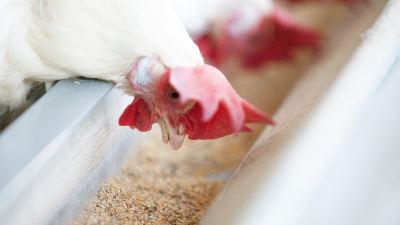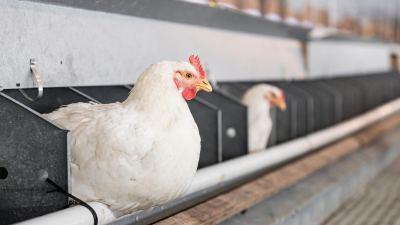Dr. Rebecca Delles: Winner winner chicken dinner

As scientific research into the exact cause and proper mitigation of woody breast syndrome continues, the issue does not pose a threat to consumer health, but rather to poultry producers' bottom line.
The below is an edited transcript of Nicole Erwin's interview with Dr. Rebecca Delles, research scientist in meat chemistry at Alltech. Click below to hear the full interview:
Nicole: Consumers are increasingly concerned with the quality of their meat and how it's produced. I'm talking with Dr. Rebecca Delles, research scientist in meat chemistry at Alltech. Her research primarily focuses on the impact of nutritional strategies on the oxidative stability of fresh meat products. Welcome, Dr. Delles.
Dr. Delles: Thank you.
Nicole: Consumer concerns with meat quality and production kind of brings to mind the old adage “You are what you eat.” How significant would you say this saying is from farm to table? In other words, how does what our meat chooses to eat affect consumer perceptions?
Dr. Delles: A great deal, to be perfectly honest. I don't think a lot of consumers really think about what the animal eats and how that impacts them at the end of the day. It's amazing how something so small, such as minerals — which are essential not just for you and me, but also for the animal themselves, and we typically add a very small amount within the diet of the animal — makes such a huge impact on the oxidative state of the animal, of the meat, and, ultimately, it will impact your health as well.
Nicole: So, if animals aren't getting what they need nutritionally, could it lead to something like woody breast syndrome in poultry?
Dr. Delles: Possibly. It's such a complex issue. To be perfectly honest, it seems like it's a multifactorial issue and that we're not quite sure exactly what's causing it. It could be that the animal themselves aren't getting the proper nutrition to sustain the type of growth rate that we're pushing. That's just due to a genetic selection. It's nothing abnormal that's going on. But it could be partially a genetic predisposition for it. I don't want to say it's just solely a nutritional component because it seems that we have to look at it more in a holistic way.
Nicole: For people who don't really know what woody breast syndrome is, can you explain that a little bit?
Dr. Delles: Yeah. The decisive marker is palpatory hardness. Is that fillet, the breast fillet, tough to the touch? That's the identifying marker, but it can range in severity. You have a normal fillet, a mild, moderate and severe. In the mild severity cases, it will be slightly tough to the touch, not too bad, and it will typically just be in one part of the fillet. But when you start seeing it in moderate and severe cases, it will be throughout the whole fillet. In fact, you can see those bulging ridges in not just the cranial portion, but also the caudal region, which is the part that tapers down. So those are typically what you see with the severe cases.
In addition to that — it's quite complex — but you can also see signs of inflammation, and that's usually basically bruising on the fillet itself. You see hemorrhages. Also, there can be exudate on the surface of that fillet, and that's only seen in severe cases. That does not reach the consumer.
Nicole: Animal rights activists have said that the condition is linked to genetics, which you touched on, and market demands that require industries to grow birds bigger and faster, causing muscle tissue to tear. Is that something that you've seen in your research?
Dr. Delles: They are correct in that there seems to be a genetic component, and it's also associated with growth rate. We are growing these birds quickly and they are big. But it's not dangerous, and we're not doing it in an inhumane way. A lot of times — and I know this starts getting into a whole pool and a different discussion, and I don't want to really go into that — but it benefits producers to have the growth rate of the bird in the production be as humane as possible. They don't want to raise these birds in inhumane conditions. Typically, that slows down growth rate, and it’s likely these animals will become sick. So, it's to the best advantage for the industry to always raise these birds in humane and healthy ways.
Nicole: When would you say that this problem started to surface, and how much can it actually affect a producer's bottom line?
Dr. Delles: This has arisen about, I would say, eight years ago, and it was a small percentage. It’s grown substantially over the past seven, eight years. It's also a global issue. We didn't really see it in the United States until about five years ago, but it was more seen in, say, Denmark and other European countries back then.
With regard to the United States, the United States government has decided to step in. Before, if you had mild to moderate severity of wooden breast, it would become a downgraded product, so, usually, it would become a processed meat product and be used in something like a hot dog, but not anymore.
The United States government decided this is becoming a big issue, and consumers are really making their voices heard, so they've decided to step in, and now they are inspecting and removing that product from that line. It is not a zero-tolerance policy. It's basically what we consider a quality adulteration. We're supposed to be selling the consumer a grade A product, and since it's not a grade A product, it's considered now a quality adulteration.
What they've decided to do is have inspectors on the line and personnel within the processing facility trying to minimize what goes to the consumer. What ends up happening is that product is completely removed, so you're having a substantial amount of money being lost. Last year, it was estimated that $200 million in revenue was lost for the United States poultry industry. Now they are anticipating that number will rise to close to half a billion dollars, if not a little bit over.
Nicole: Well, could woody breasted meat still be cooked and eaten safely?
Dr. Delles: Yes. It's not dangerous to the consumer. It's not dangerous if you have a tough fillet and you decide to give it to your dog. It's not dangerous whatsoever. The consumer could eat it. They would be fine. It's just more of a palatability issue. They don't like how it tastes. They don't like the texture of it. So, if you were to give it to your dog, that would be perfectly safe for Fido.
Nicole: Are there ways that you could cook it, maybe, to make it taste a little bit better?
Dr. Delles: There's been quite a bit of research done by multiple universities throughout the entire world. There’s been work on increasing the palatability of the chicken through a marination approach. Also, you can make a processed meat product with the chicken. For example, you could make a sausage out of it and use other compounds.
Nicole: So, you're doing a value-added product.
Dr. Delles: Exactly.
Nicole: Okay. Woody breast sounds like it would be limited to birds. Are similar characteristics found in other meats that we consume but just simply called by another name? Or is it mainly a poultry problem?
Dr. Delles: This appears to be just solely a poultry problem. You have the exact opposite issue when we're talking about other quality deterioration within meat products. Pale, soft and exudative meat — or PSE — can be seen in poultry, but I wouldn't really characterize that as a myopathy. That's more about how stressed the animal was upon entering the slaughtering facility. That work has been very well-characterized, and we now know what we can do to minimize that impact.
Nicole: What are some quality issues noticeable in pork?
Dr. Delles: In pork, mainly it's pale, soft and exudative meat. That issue was probably around 20 years ago. They did a lot of research on that, and they know exactly what causes it. There used to be a genetic component to that as well, but they were able to breed out that issue.
Another issue that you can see in pork meat could be dark, firm and dry. Typically, we don't see that very often. You can see it more in beef products.
Nicole: Can some of these issues be curtailed through nutrition?
Dr. Delles: Yes, you could take a nutritional approach to it, making sure that you are feeding the animal appropriate diets. But, to be perfectly honest, I think management is the best way to tackle that particular issue.
Nicole: How holistic should the approach toward a nutritional management plan in livestock be when producers are considering their feed?
Dr. Delles: I would relate that a lot to what you want in your diet and your lifestyle. People and animals go hand in hand. A lot of times you hate to admit it, but your parents or your guardians are right. You want to eat a healthy, balanced diet, exercise, but everything in moderation. So, when we're talking about animal nutrition, we want to make sure that the animal is cared for in the proper way. You want to feed them the diet that they need to grow properly, to remain healthy, but management is also a very important part of that as well. You don't want these animals to be overly stressed because they're not going to feel hungry. They're not going to eat. They're not going to grow properly. You're completely right when you're talking about looking at it as a holistic approach.
Nicole: What should consumers keep in mind when they look at a package at the store before buying, if they're trying to consider all of these things?
Dr. Delles: I would always say, “Eat with your eyes.” You want to make sure that the product looks fresh, looks wholesome and looks like it will be delicious. You want to make sure when you're looking at that product that it looks uniform. You don't want to see some discoloration in certain areas. It’s not that it will be dangerous, it's just that it's been oxidized more so than a product that looks completely pink, such as your pork chop. If you have a completely pink pork chop, you don't want to see little areas of discoloration. Not that it's not fresh, but it just means it's been oxidized. That could be from the nutritional standpoint of the pig or it could be a processing issue or packaging issue. Knowing exactly what that causes is pretty hard to pinpoint when you're just looking at a package.
Nicole: Anything that you look forward to in our future abilities to alleviate these kinds of concerns?
Dr. Delles: I hate to say it, but I find the whole wooden breast issue exciting. As a meat scientist, it's fascinating. We have never seen anything like this before. So, meat scientists are all talking, and we all congregate and we all share ideas. Everybody has a different approach to it, which is absolutely fascinating. From a meat scientist standpoint, or even a protein standpoint, it's really amazing to see what can occur when you don't have all the components perfectly together. I see this issue continuing. I see it improving shortly. Hopefully, we'll be able to remove that issue altogether.
But what I'm really hoping to see is someone coming up with the exact cause and the complete mechanism of what is going on. To be honest, we will have to figure out the whole biochemical process of the conversion of muscle to meat, and that's going to be quite time-consuming. We've been working on it for decades. Even to this day, people are coming up with new concepts and figuring out small pieces to this whole puzzle. I don't see us having this issue in other animals such as beef or pork.
I hate to say it, but I think we might see another myopathy in poultry occurring called spaghetti meat. That seems to be the exact opposite of wooden breast meat, but it seems to be making its way globally and slowly becoming a bigger and bigger issue. It might be because the genetics of these animals are a little more limited than what's seen in the pork and the cattle industry.
Nicole: With the spaghetti meat, because you mentioned it, is that also safe to consume like the woody breast?
Dr. Delles: Yes, it's perfectly safe to consume. It's just the exact opposite texture. With woody breast, you typically see fibrosis, which is collagen. You have more connective tissue. When we're talking about spaghetti meat, you don't have as much collagen that's needed to support that muscle fiber — the whole muscle itself. It’s two ends of a spectrum and it's pretty fascinating to see. I'm hoping that talking to other meat scientists and protein chemists, we'll be able to come up with a solution to the problem soon.
Nicole: Dr. Rebecca Delles is a research scientist in meat chemistry at Alltech. Thank you so much.















